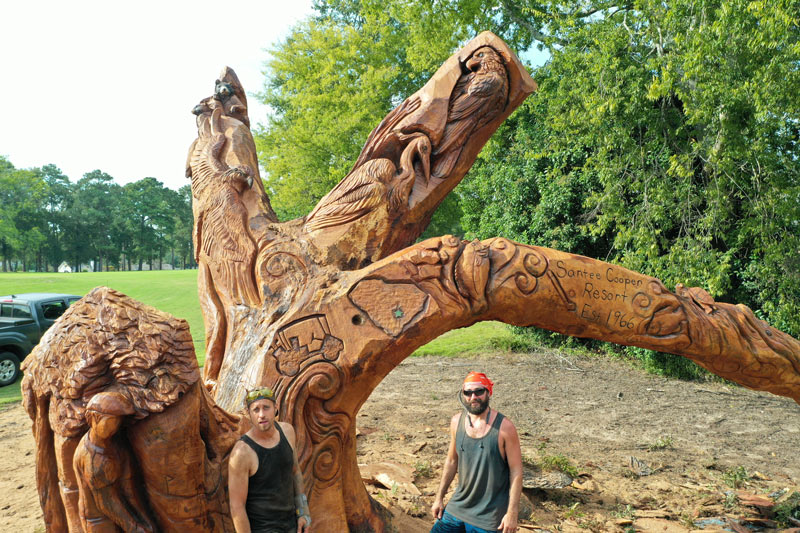
Artists Kyle Thomas (left) and Corey Lancaster enlivened what still stands of a once-towering southern oak with carvings of popular outdoor pastimes. The tree is located on the fifth green of Santee Cooper Country Club in Santee, S.C., part of Santee Cooper Resort. Photos by Gene Scarborough
Like many golf course superintendents, Gene Scarborough has a love-hate relationship with trees. While Scarborough, the GCSAA Class A superintendent at Santee Cooper Resort in Santee, S.C., can appreciate their lovely leafy aesthetics, he’s well aware of the challenges they can present in the golfscape.
“I try not to plant trees on the golf course,” says Scarborough, a 36-year association member. “Trees are beautiful. But one time I played a course with only one tree on the whole golf course. That’s my kind of golf course.”
Santee Cooper Resort had plenty of trees when Scarborough arrived there nearly 24 years ago, but one stood out. And although it has suffered a slow death in the intervening two decades and its estimated quarter-acre canopy is long gone, that once-stately live oak now stands out again — thanks to Scarborough’s epiphany, the resort’s artistic golf pro, and the nearly weeklong chain saw work that turned the tree not into a memory but a standing work of art.
“We were able to take something that was dying — that was dead — and, instead of just having a stump and then having to grind that stump up, we were able to make something very unique,” Scarborough says. “I’ve not heard of any other golf courses that have something like this.”
In mid-September, the resort commissioned two chain saw artists from North Carolina to transform what remained of the southern live oak (Quercus virginiana) into a signature art piece celebrating life in Santee. Designed by Santee Cooper’s PGA professional, Steve Smart, the art features images representative of the town’s most popular pastimes — outdoor recreation, hunting and fishing associated with adjacent Lake Marion, and, of course, golf.
“It’s generated a lot of interest in the community,” Scarborough says. “I think it turned out pretty cool.”
It was a different kind of cool when Scarborough first came to Santee Cooper Resort. The live oak, which Scarborough estimates to be around 60 years old, was featured on the course’s logo, flags and stationery. Located near the Santee Cooper Country Club course’s No. 5 green, it was hard to miss for folks driving onto the grounds.
But even in Scarborough’s early days, it was obvious the tree was starting to decline. He says a fungus, not insects, was the cause of death.
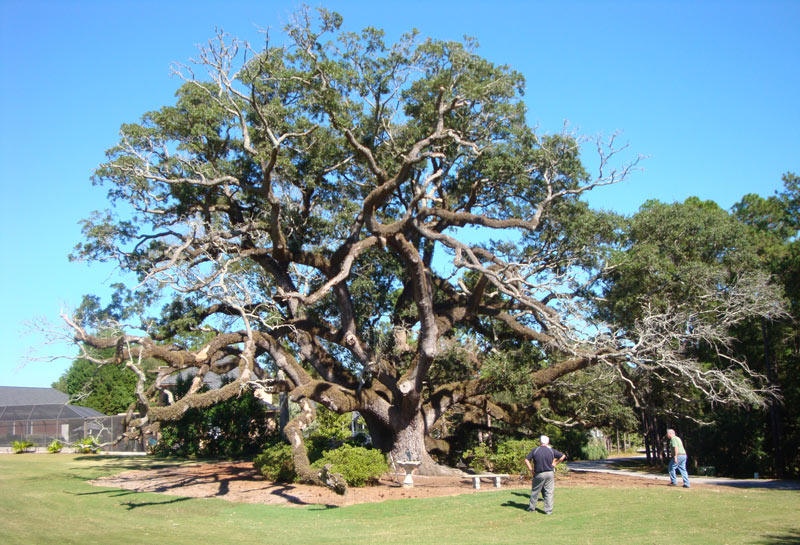
A drawn-out decay: The southern live oak in October 2009.
“We had a professor from Clemson come out and said it was dying a slow death,” Scarborough says. “You never know how long it will be before it’s totally gone, but it declined rapidly. We started pruning this tree over time, cutting the deadwood off of it. We had to cut half the tree down, but it kept dying, and it became a safety issue. It’s by the road and by a green, so we made the call to cut the rest of the tree down.”
That’s when Scarborough had his aha moment. Rather than taking the whole tree, the crew took only the most egregious deadwood, leaving behind the trunk and portions of three branches. Scarborough pitched the art idea to the resort’s general manager, Smart sketched out his vision, and Scarborough started looking for chain saw artists.
“I’d say it’s been a year and half, two years,” Scarborough says. “People would ask me, ‘What are y’all doing with that tree?’ I’d say, half-teasingly, ‘It’s modern art. You know when you walk in an art museum, and you look, and you have no earthly idea what it is? That’s what this is. But we have a plan to make it into artwork.’”
Scarborough’s scouting turned up a few artists, with bids from $8,000 to $60,000. “We thought $60,000 was a little excessive,” he says.
A combination of community fundraising and contributions from the resort company raised the $16,000 to pay the two North Carolina artists — Kyle Thomas, of Red Rabbit Wood Carving in Raleigh, and Corey Lancaster, of Boon Hill Gallery in Princeton — for their five long days of carving. Scarborough estimates the trunk’s circumference at 19 feet.
“They (Thomas and Lancaster) were like, ‘Wow. We’ve never done anything like this,’” Scarborough says. “They were here five days, and they probably would have been done sooner, except people kept coming up and asking them about it.”
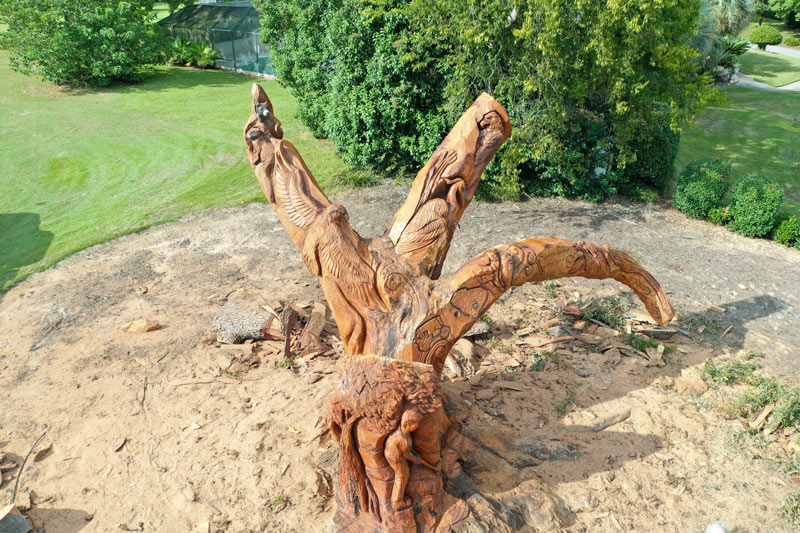
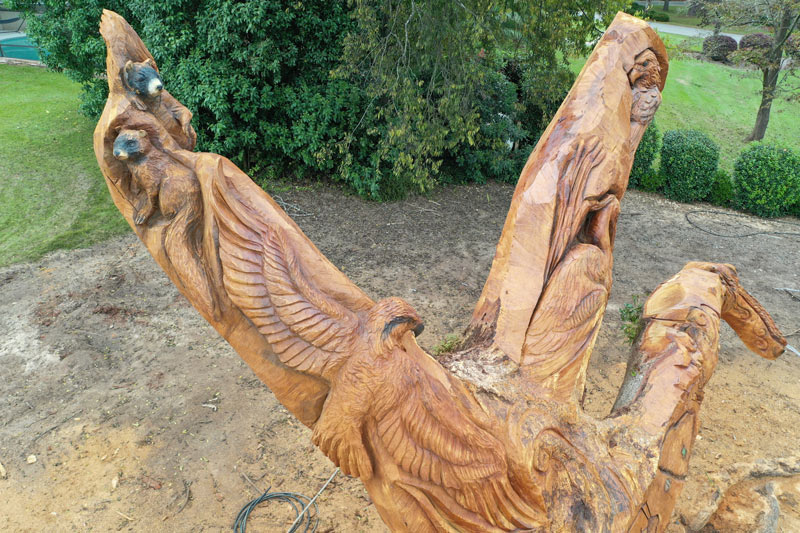
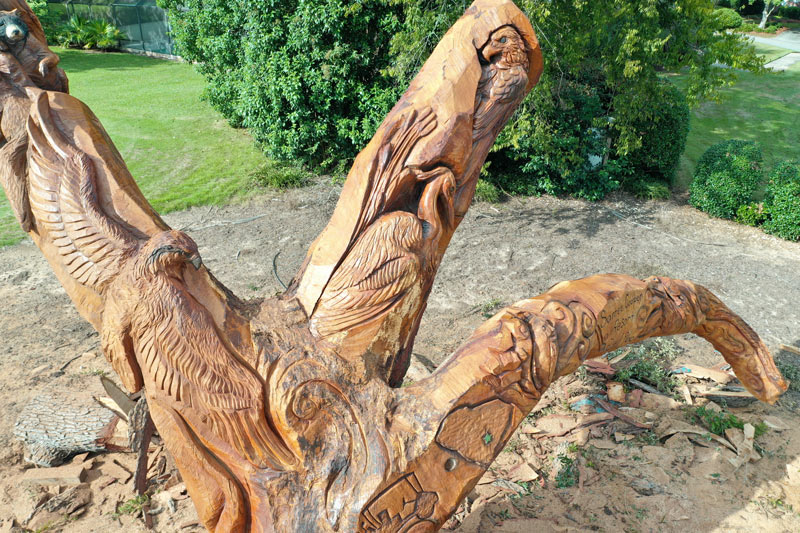
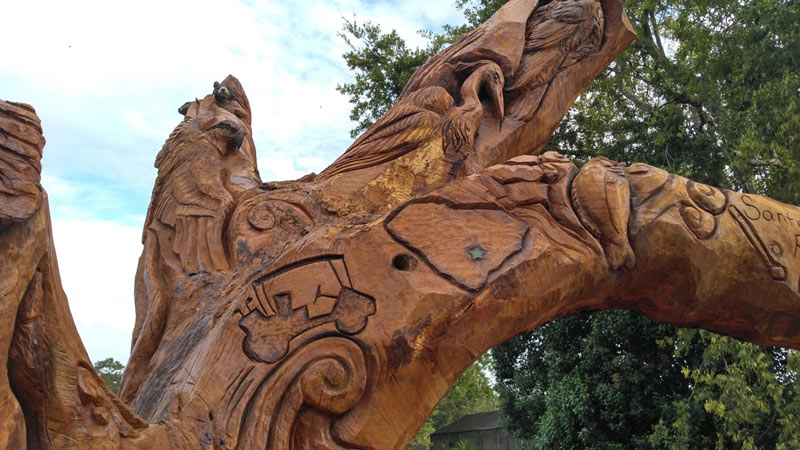
The artists applied an Australian timber oil to the carving to protect it, and Scarborough and his team will have to reapply the oil yearly for the duration of the tree’s (new) life. Scarborough also plans to invest another few thousand into landscaping, a bench, lighting and irrigation around the art installation.
“I have no earthly idea how long it will last,” Scarborough says. “It’s live oak. You know Old Ironsides — the USS Constitution? The USS Constitution was made with live oak, and cannonballs would hit it and bounce off. This wood is extremely dense. When it’s dry, it’s even worse. That wood is hard. Hopefully it’ll last us another 20, 30, 40, 50 years.”
And maybe by then, another of Scarborough’s visionary plans will have grown into its own. Despite his insistence that he generally doesn’t plant trees on the courses (and contrary to the half-serious accusation that Scarborough actually murdered the tree that became art), he planted another live oak on the course, out of play, about 10 years ago.
“It is visible from the road, but most people don’t notice it yet,” Scarborough says. “Hopefully, one day, it will become another large oak signature tree.”
Andrew Hartsock is GCM’s managing editor.